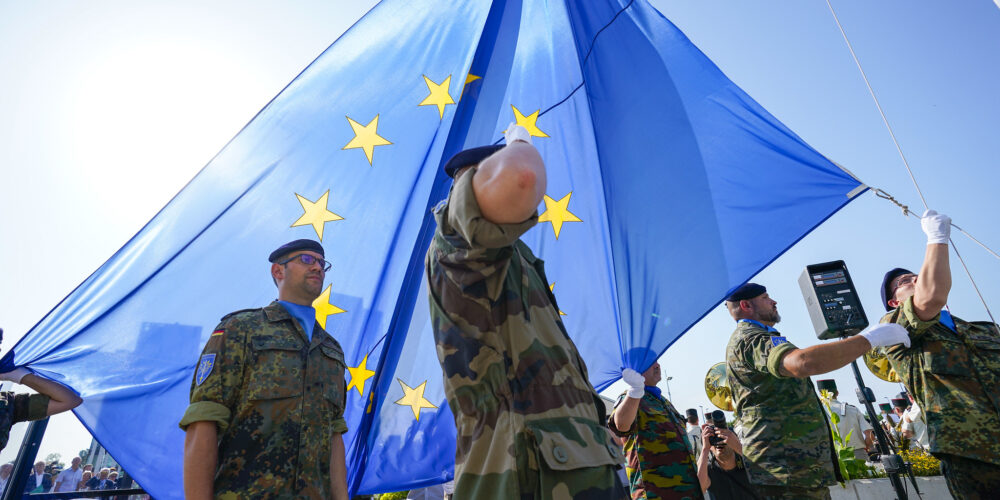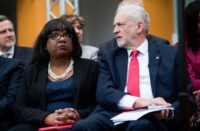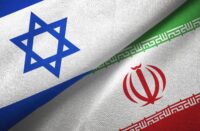“Oh what a tangled web we weave, when first we practice to deceive” – Sir Walter Scott’s poem Marmion (1808).
The proxy war being fought out Ukraine between NATO/EU and Russia – fought over an ever-growing mountain of Ukrainian and Russian dead bodies – has been the pretext for the Irish government’s growing efforts to mould, shape, pressurise and bamboozle the people of Ireland to go along with its strategy to abandon the Triple Lock and to end the neutrality of the state.
The Ukraine proxy war has also been used to push forward the growing and deepening militarisation of the EU. It has been the pretext for the ramping up of military spending and rearmament. History continues to show us that when the ruling establishment can’t convince the people that the course of action they wish to pursue is our only option allowed, they follow the well-worn path of laying down “a tangled web [they] weave”. The “Russian threat” is just such a “tangled web”.
The Irish government has used the war in Ukraine to manufacture consent to abandon the Triple Lock and neutrality. While, at EU level, it is being used to justify ever-increasing spending on arms and militarisation. Yet when it comes to ending the genocide in Gaza by the zionist state, or sanctioning it for its ongoing and brutal assaults and illegal wars and invasions of neighbouring countries like Iran, Lebanon, Syria, Yemen, nothing can be done. No action can be taken nor sanctions imposed upon the aggressive zionist state. Why? Because the zionist state is a strategic asset for imperialism in the region. Rather, the EU member states provide absolute and unquestioning political cover as the EU continues to supply military equipment and logistical support to the zionist state.
The latest announcement in this regard came in late June by Tánaiste and Minister for Foreign Affairs, Simon Harris, informing us that this state would be joining a new EU “defence” initiative that will allow member states to jointly procure military equipment. The EU regulation, known as Security Action for Europe (SAFE), is part of a wider military build-up strategy called the European Defence Initiative. The Irish government claims they need to invest in artillery, drones, cyber- and air-defence systems and new personnel carriers.
The SAFE process will allow member states to borrow more for spending on militarisation, but that additional spending will not impact upon the EU’s fiscal rules in relation to state borrowing. As with all these processes, this current initiative, SAFE, will only be the start. The initial phase has been designed to relax EU procurement rules for buying military equipment. It will make €150 billion available to member states in the form of low interest, long-term loans in order to scale up increase spending on defence. The government is selling membership of SAFE as best way to get the best deal, more bombs for your euro, in its strategy to upgrade the Irish defence forces.
Weapons manufactures will be laughing all the way to bank as the scale of rearmament grows.
SAFE is part of the “rearm Europe Plan” proposed by Ursula von der Leyen when she outlined key areas for speeding up the rearmament of Europe, relying upon market forces to provide the money as loans to member states who wish to invest in capabilities including missile defence, artillery systems, missiles and ammunition, drones and anti-drone systems, or in military mobility.
The EU will guaranteed these loans within the EU budget. This new instrument (SAFE) was established under Article 122 of the Treaty of the EU, without approval from the European Parliament.
Thereby it is ensured that member states can exclude increased defence spending from their national expenditure, thereby not running the risk of breaching the EU’s own fiscal policy rules, which currently state that governments’ deficits and debt must remain under 3% and 60% of GDP.
For example, if the Irish state wanted to borrow money to build public housing and that borrowing breached EU fiscal rules, they would be penalised and forced to pay fines. So it’s better to borrow money for weapons of mass murder, that may be used to destroy people’s houses, than to build housing for the people. The madness of capitalism.
Other element proposed by Ursula van der Leyen included “allowing member states to make more ample use of cohesion policy programmes to increase defence spending, expanding the mandate of the European Investment Bank so it boosts financing of defence projects and accelerating the Savings and Investment Union to enable private banks to pour more money into the sector too.”
She went on to state that “we (the EU) will need to increase that number considerably once again. Because from just below 2% to above 3% will mean hundreds of billions of more investment every year. So, we need a bold approach.” They are currently finalising an agreement on changes to the European Investment Bank (EIB) lending rules to private European banks.
The EU militarisation strategy is to see investment grow in the military industrial complex by aiming to inject €800 billion into the EU’s defence industry over the coming years. One of the key targets is to get their hands on the €1.4 trillion in households’ savings which they want to encourage to be invested in the military industrial complex.
Defence spending increases. In 2022, collective annual EU defence budgets had already increased to €240 billion, of which €58 billion (+24.2 % compared to 2021) was for defence investment (defence R&D and defence procurement), a real increase of more than 6 % compared to 2021.
Joining SAFE is a significant step forward in the government’s strategy to break the Triple Lock and get ride of neutrality. It is a major step forward in harmonising weapons, military structures and practices. Traditionally, the Irish defence forces were trained for peace-keeping and defence of the civil powers. All NATO member states military are trained in the main for attack and strategic interventions.
It is clear military spending will only grow, and more scarce resources, both natural and human, will be wasted. Growing militarisation will only exacerbate the climate crisis: the military is one of the great global polluters.
Militarism and increased military spending does not make us any safer but rather makes our world more unsafe, more unstable. The global military-industrial complex and finance houses will get richer, while the services we rely upon will only further deteriorate. It’s a win-win for capitalism and lose-lose situation for working people and the environment.






